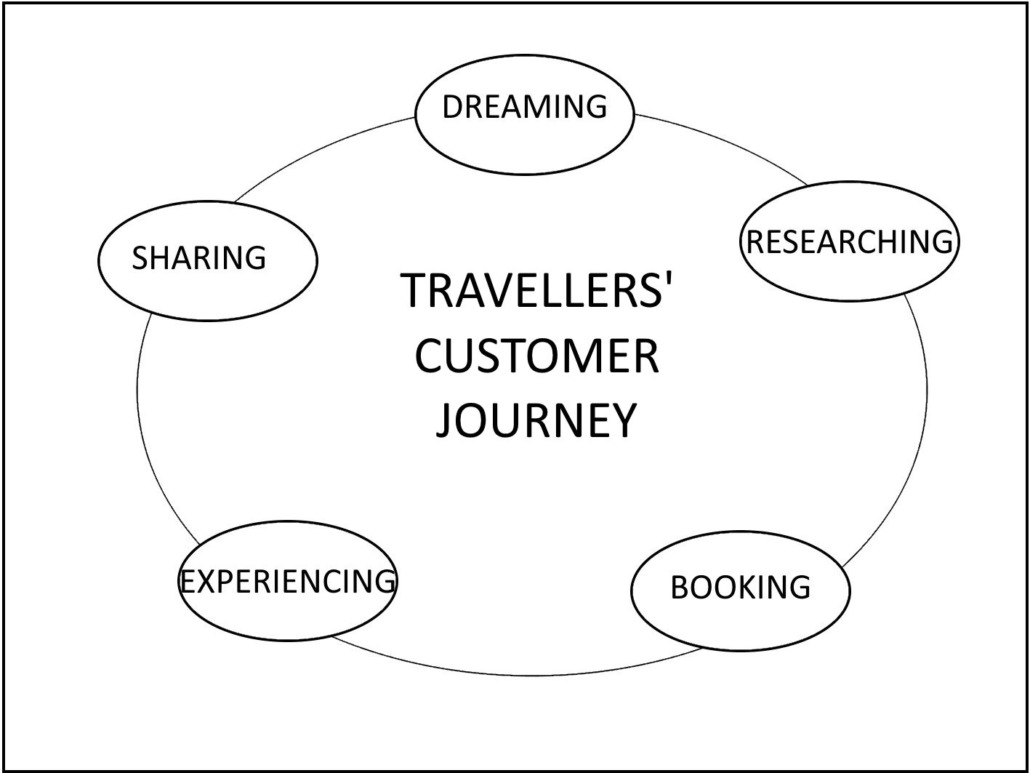The Five Stages of a Tourist’s Customer Journey

According to the UNWTO (World Tourism Organization) [López de Ávila A., 2011], a tourist’s customer journey (the process that characterizes the interaction between consumer and brand, from need to purchase and post-purchase) consists of 5 stages [Fig. 1]:
- Dreaming
- Researching
- Booking
- Experiencing
- Sharing

Fig. 1 – The Tourist’s Customer Journey (own elaboration)
The Dreaming stage is the most critical phase of the tourism customer journey, as it is when the tourist starts to consider traveling without a clear idea of where to go. Tourists search for information, compare offers, ask for advice, and typically use the internet as a source of inspiration, utilizing search engines, social networks, blogs, travel websites, and encountering shared tourist content (texts, photos, videos) from destinations, operators, residents, media, influencers, and other tourists.
The Researching stage involves the tourist investing time in a more in-depth exploration of potential destinations and the feasibility of their travel intentions (prices, availability, offers, services, connections, etc.). They use numerous online services like TripAdvisor, Booking, eDreams, Expedia, Airbnb, Trivago, Skyscanner, etc. Opinions from other users, tourists, or influencers remain crucial at this stage.
The Booking stage increasingly occurs online, particularly for short and medium-haul trips or short and medium-duration stays. However, traditional travel agencies and tour operators still play a significant role, especially for long-haul or extended-duration trips. Tourists book necessary resources, such as accommodations, transportation, local activities, and event tickets. Online bookings have grown exponentially on desktops/laptops and mobile devices. As a result, booking websites must be intuitive, easy to use, responsive (adapting to the tourist’s device), and offer optimized mobile apps. Tourists place greater trust in other users’ reviews than in institutional advertising, which has lost credibility.
During the Experiencing stage, tourists seek contextually relevant information and content at their location, tailored to their interests and passions, primarily using smartphones. Responsive websites, apps, web apps, and social channels must provide real-time access to routes, recommendations, schedules, maps, transportation, events, services, and any other information the tourist may need during their stay. Tourists increasingly access real-time information upon arrival at their destination instead of preparing in detail in advance.
In the Sharing stage, tourists share opinions, information, and content (texts, photos, videos, stories, reels) about their vacation in real-time or later (creating albums, retouching photos, or editing videos more structurally). This sharing is made possible by smartphones, increasingly widespread free Wi-Fi, and reduced data costs (5G, 4G) even while roaming. These valuable feedback (photos, videos, reviews, opinions, or general information about the trip or destination) influence other tourists’ decisions and the actions of operators and DMOs (Destination Management Organizations) that can capitalize on this information.
Bibliography
- [Lopez de Ávila A., 2011] Antonio Lopez de Ávila, “Technology in Tourism” affiliate members am-reports, World Tourism Organization (UNWTO), 2011
- [Rossi A., 2022] Rossi Andrea, “Comunicazione Digltale per il Turismo”, Rossi A., 2022, ISBN 9791221004175
#TouristCustomerJourney; #TravelPlanning; #DreamExploreBook; #TravelStages; #TravelExperience; #TourismInsights; #DigitalTourism; #UNWTO; #TravelSharing; #SmartTravel

Leave a Reply
Want to join the discussion?Feel free to contribute!